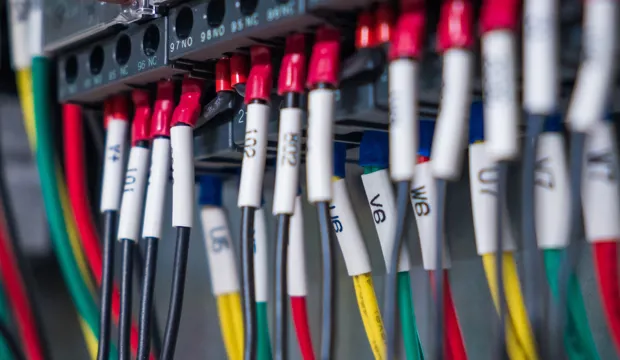
Micro:bit food temperature probe design project
Creating a working prototype of a food temperature probe
This activity tasks students with using the micro:bit to develop a prototype for a food temperature probe that will warn people when their food is too cold.
It’s an ideal lesson for introducing students to programming, allowing them to develop their skills, make use of programmable components and even embed intelligence into a product’s design.
This is one of a series of resources to support the use of the BBC micro:bit in design and technology (DT) or computing lessons. It can be taught as a main lesson activity with Programmable systems as a starter activity, and Product integration as an extension activity.
Activity: Creating a working prototype of a food temperature probe
The activity starts with students being briefed on the importance of food being prepared or cooked to the correct temperature. Too cold and it could cause food poisoning, too hot and it could burn. Learners will then be asked to use this knowledge to develop a temperature monitoring system using the BBC micro:bit.
To create a micro:bit food temperature probe, students must:
1. Understand the brief
Using the Developing the programmable system presentation, students will review the design brief, including the background information on the importance of food temperature.
2. Review the system diagram
Students will review the presentation, which shows a system diagram, which shows the physical parts of the system as well as the signals. They will then discuss how input (temperature), process, and output (warning sound) should work in this system.
3. Follow the design criteria
Students will review what the system needs to do for it to function correctly. This system must:
- Be programmable using the micro:bit.
- Use a suitable sensor to detect the temperature of the food that has been cooked.
- Use a buzzer or beeper to make a warning sound if the food is too cold for it to be safe to eat.
- Display the temperature of the food using the micro:bit’s inbuilt LED screen.
4. Choose an input device
Students must select a suitable temperature sensor (e.g., thermistor or digital temperature sensor). This may depend on what’s available at your school!
5. Choose output device
Students will then pick a buzzer or beeper for making the warning sound (again, depending on what the school has available). They’ll need to attach the buzzer and sensor to the correct ports of the BBC micro:bit, using a suitable connector such as crocodile clips or block connectors.
6. Code the Program
Students will then write their programme, using the either the JavaScript Blocks Editor or Python Editor. Example programs can be used as guides where necessary (see below).
7. Download and test their programme
Students will download their programme onto the micro:bit and make adjustments and improvements if it’s thought to be necessary.
Where can I find the example programme for creating a food temperature probe with the BBC micro:bit? (H2)
The instructions for where you can find and download the example programmes for the JavaScript Blocks Editor and Python Editor are below:
Example Thermometer Program – JavaScript Blocks Editor
- Go to www.microbit.org/code and open the JavaScript Blocks Editor.
- Drag the file microbit-temperature-jsb.hex onto the work area.
- With the correct ‘m’ and ‘c’ values added this program will act as thermometer and display the temperature.
- Test it, download it and experiment with how it works!
Example Thermometer Program – Python Editor
- Go to www.microbit.org/code and open the Python Editor.
- Drag the file temperature.py onto the work area.
- With the correct ‘m’ and ‘c’ values added this program will act as thermometer and display the temperature.
- Test it, download it and experiment with how it works!
How do you calibrate the thermistor?
The thermistor is a sensor that changes the resistance based on temperature, allowing the micro:bit to measure how hot or cold things are. To make sure that the readings are accurate, we have a Calibrating thermistor handout to help. Teachers can calibrate the thermistor for less-advanced students or higher-ability students can try themselves as part of the activity.
The handout also explains what is meant by the terms ‘ADCValue’, ‘m’ and ‘c’ used in the thermometer program, why they are there and how they are worked out.
The engineering context
Being able to accurately monitor temperature is important within several industries including food, healthcare, electronics, energy, defence and chemical manufacturing. Engineers must therefore design systems that can not only easily monitor temperature but also automatically trigger warnings (such as alarms) or safety mechanisms (such as cooling systems) to regulate temperature.
Suggested learning outcomes
Learners will be able to understand a block systems diagram of the food temperature probe system. They’ll be able to successfully program the BBC micro:bit so that the system meets the design criteria, being able to choose appropriate inputs and output device for the system they’ve designed.
Download our activity sheet and other teaching resources
The activity sheet includes teachers’ notes, useful web links, and links (where appropriate) to the national curriculum in each of the four devolved nations; England, Northern Ireland, Scotland and Wales.
All activity sheets and supporting resources are free to download, and all the documents are fully editable, so you can tailor them to your students’ and your schools’ needs.
Download our classroom lesson plan and presentation below.
Please do share your highlights with us @IETeducation.
Available Downloads

Activity overview
Design a food temperature probe activity description, teachers' notes and curriculum links.

Presentation
PowerPoint outlining how to run the activity

Handout
Developing the programmable system for the temperature monitor - student handout with example programs.

Handout
Calibrating the thermistor.

Hex program
Example programming file using the JavaScript Blocks editor

Py program
Example programming file using the Python editor

Hex program (ADC value)
Example programming file using the JavaScript Blocks editor to find the ADC value

Py program
Example programming file using the Python editor to find the ADC value


